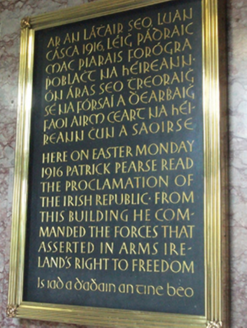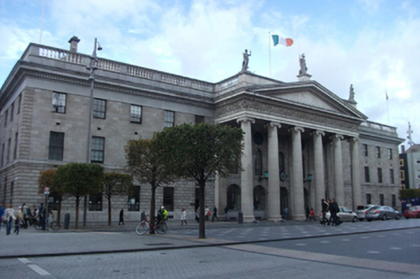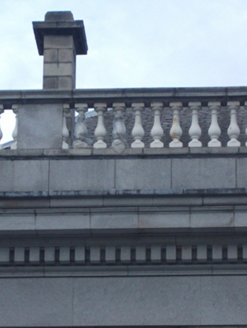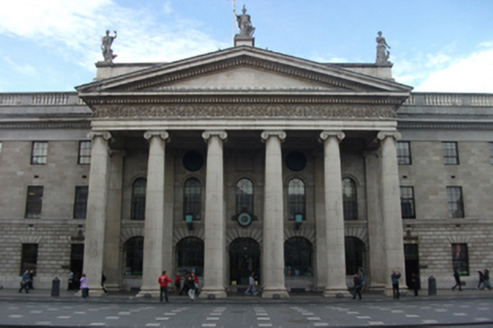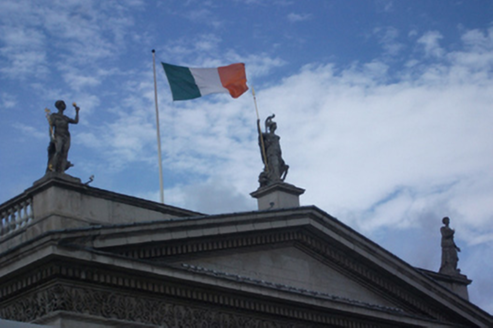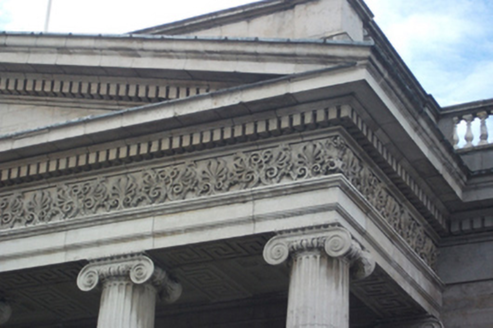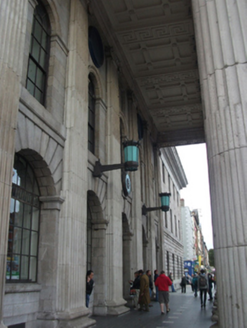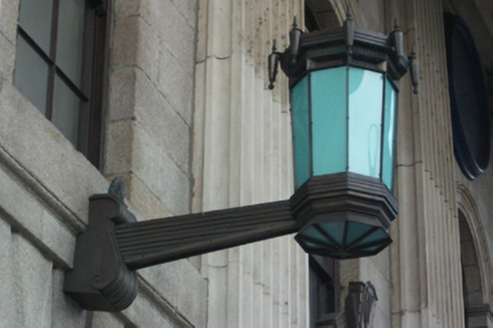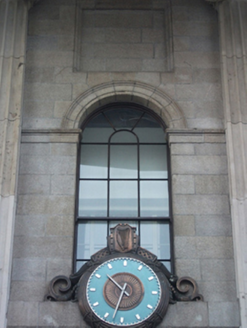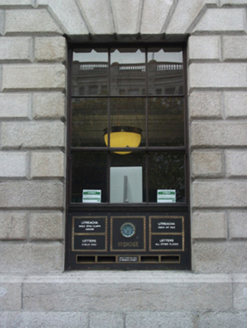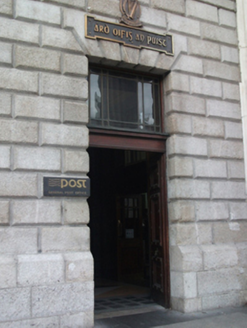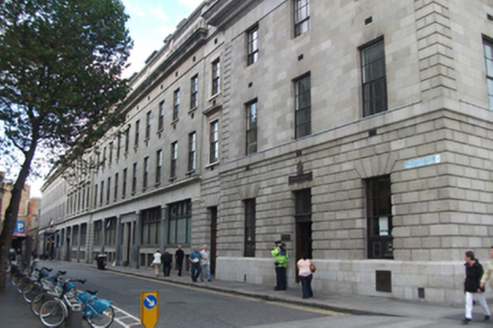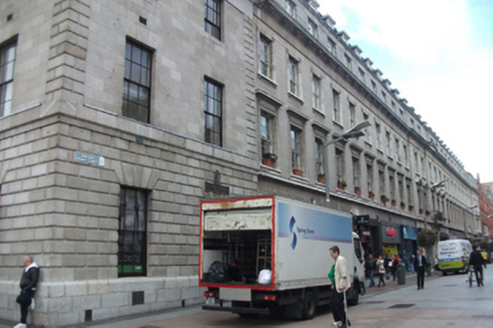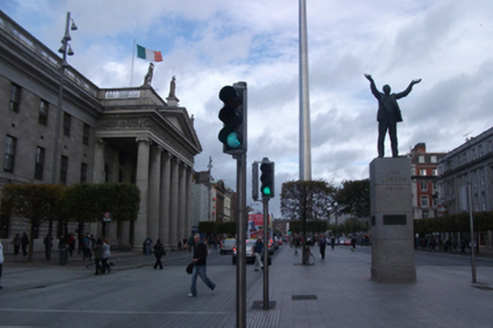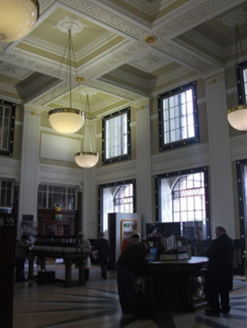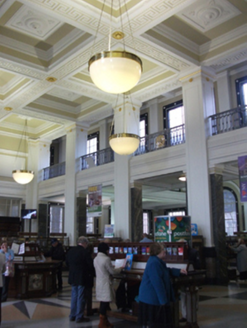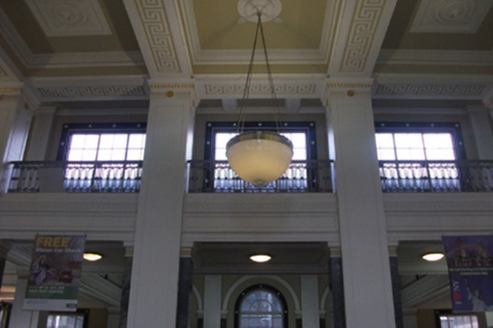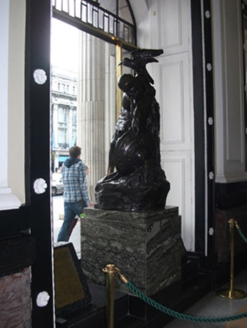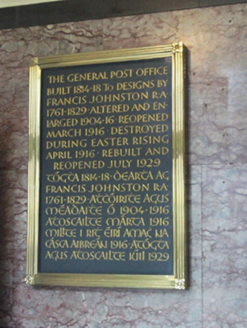Survey Data
Reg No
50010528
Rating
National
Categories of Special Interest
Architectural, Artistic, Cultural, Historical, Scientific, Social, Technical
Original Use
Post office
In Use As
Post office
Date
1810 - 1935
Coordinates
315881, 234624
Date Recorded
05/10/2011
Date Updated
--/--/--
Description
Symmetrical neoclassical fifteen-bay three-storey central post office over concealed basement, built 1814-18, to designs of Francis Johnston, with hexastyle Ionic portico. Remodelled 1905-15 to designs of J. Howard Pentland. Extensively damaged during 1916 Rising and rebuilt 1925-32 by Office of Public Works on U-plan with central courtyard and thirty-bay returns to flanking side streets. Pitched natural slate roofs with rolled lead flashing, hipped to corners and set behind balustrade granite parapet wall with Portland limestone balusters. Central pedimented prostyle hexastyle Giant Ionic portico built in Portland limestone and extending onto pavement. Pitched lead-lined roof set behind parapet wall surmounted by three replica cast statues on plinths. Lead-lined dentillated pediment with anthemion frieze and architrave supported on six Giant Ionic order fluted columns, cable mouldings to lower third, with attic bases and plinths. Responding fluted Ionic pilasters abut façade flanking each bay. Greek key pattern to soffit of architrave and coffers to soffit of portico with Greek key beams spanning column to pilaster. Squared coursed granite ashlar walls, rusticated to ground floor on raised moulded granite plinth course with rusticated quoins to either end and surmounted by dentillated deep cornice below balustraded parapet. Round-headed window openings to portico, first floor windows having moulded architrave heads with impost mouldings, sill bands between pilasters and hardwood sash windows. Blind square panels above each window opening with central bronze clock to central window sill. Voussoired window openings to ground floor with impost mouldings and inset decorative bronze multiple-pane windows set on granite sills. Square-headed window openings to remainder with six-over-six pane hardwood sash windows, flush sills to second floor, continuous sill band to first floor and voussoired rusticated heads to ground floor windows. Either side of portico is square-headed door opening with voussoired heads and double-leaf hardwood panelled doors with bronze overlights. Original front block has three bay side elevations to north and south, detailed as per front elevation. Late 1920s interior to main hall accessed through door openings to either side of portico, both having draught lobbies with terrazzo floors, decorative Kilkenny limestone, pink marble and Connemara marble piers with plaster egg-and-dart cornice below coffered ceiling with panelled beams and polished timber glazed entrance screens to main hall. Double-height main hall occupies main body of building behind portico having terrazzo floor with geometric design, elaborate plaster pilasters to coffered plaster ceiling with Greek key downstanding beams, plaster ceiling roses and panels. To rear of hall is mezzanine level with iron balustrade with ground floor level extending into rear courtyard and having Connemara pilasters. Elaborate polished timber counters with brass grilles to rear with matching public writing desks and post boxes having brass embellishments in Empire style throughout hall. Central window to portico has bronze sculpture of legendary hero Cúchulainn on Connemara marble plinth by Oliver Sheppard. To either side of main hall is long single-height room with terrazzo flooring, plaster piers and beams and marble counters.
Appraisal
O’Connell Street, formerly known as Sackville Street, was laid out from 1749 by Luke Gardiner who demolished earlier buildings to make way for the grand thoroughfare. Adjacent to Nelson’s Pillar, the General Post Office was constructed in 1808 to designs of Francis Johnston, replacing the GPO on College Green. Extensively remodelled in 1905-15 by J. Howard Pentland, the building was most famously the stronghold of Patrick Pearse and his rebels in the 1916 Easter Rising and, along with much of O’Connell Street Lower, was reduced to a burnt-out shell. The building was only cleared of debris in 1924 when the Free State government approved reconstruction plans, carried out principally by T.J. Byrne and J. Fairweather and reopened in 1929. The sumptuous neoclassical interior is of major architectural importance in its own right and elevates the historic building to more than a mere example of façade retention. As the site of the Proclamation of the Irish Republic by Patrick Pearse and as a monument to the struggle for Irish independence, the building is a reminder of the seminal conflict that changed the course of Ireland's history. Relics of particular conservation importance are the small scars and bullet holes in the main façade, columns and portico sustained during the Rising. Although the building was extensively restored and altered, Johnston's principal elevation was retained and the Giant Ionic portico remains the focal point of Dublin's principal thoroughfare, recently enhanced by the formation of a plaza to the front. The site and the building represent both the colonial and republican aspects of Ireland's history while continuing to serve its civic function as originally intended.
